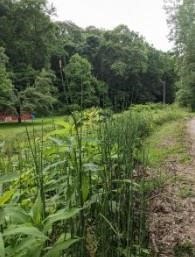By Christine Gelley
Toxic plants that may appear in pastures and hayfields should be something all livestock managers scout for. In my experience, it is the equine managers that are particularly concerned about their animals’ welfare, that is, once they discover that a toxic plant is present. There are so many possible poisonous plants to be familiar with, it can be overwhelming. It is important to remember that the most common situation where an animal is poisoned by a toxic plant is one where there isn’t enough good forage to eat. Overgrazed pastures or forced feeding of hay containing toxic plants are a recipe for disaster.

All parts of horsetail are poisonous if consumed!
One such plant that should be the star of its own horse tale (and Netflix documentary) is a plant called horsetail. The genus name of the horsetails is Equisetum. The one most commonly encountered type in Ohio is also known as scouring rush. Interestingly enough, horsetail is more closely related to ferns and pine trees than it is to rushes. It is an ancient non-flowering, cone producing, spore releasing plant. According to paleobotanists, it is far more ancient than the dinosaurs. It has been found in the fossil record occurring as tree sized plants in the Carboniferous period, although now they are more commonly found at a height of four feet or less.
Horsetails are commonly found in marshy areas and ditches. All parts of the plant are poisonous if consumed by creatures, but horses seem to be the most sensitive of the grazing livestock. It grows in colonies connected by a network of underground roots (rhizomes) that often look like a collection of green and jointed straws sticking up out of the grass. Its leaves occur as scales along the upright hard and hollow stems, giving it the appearance of a stripped bamboo stalk. Poisonings are not common from this plant, but animals should be segregated from areas where it is found.
Due to the biology of this ancient plant, it is generally not controlled by the herbicides usually recommended for forage or forest ecosystems. One herbicide that shows promise is Permit, which contains halosulfuron, and is the go-to herbicide for nutsedge. We shouldn’t be surprised by its persistence, since it has survived a speculated 325 million years. The good news is, mowing it is pretty effective at suppressing growth. Tillage however, can make matters worse.
If you discover horsetail on your property, there is no need to panic. Isolate it from areas where livestock graze or hay is made and mow the area to keep spread minimal. For this weed, the best control is the knowledge that it exists and is poisonous. We will probably never eradicate it, nor would we want to, so its best to learn to live with it in our midst.
Now I’m off to see the new Jurassic World movie, while I imagine horsetails that grow as tall as houses, and dream about being cast as a paleobotanist or sauropod grazing manager in my own version of the story. Happy hay season all! Stay safe and hydrated while doing what you do.
Source : osu.edu